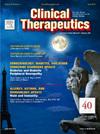葡萄柚汁联合低剂量Venetoclax治疗不适合强化化疗的AML患者的安全性和有效性。
IF 3.6
4区 医学
Q2 PHARMACOLOGY & PHARMACY
引用次数: 0
摘要
目的:Venetoclax联合低甲基化药物(HMAs)已成为急性髓系白血病(AML)患者不适合强化化疗的标准治疗方法。然而,其高昂的成本限制了其在中低收入国家的可及性。本研究旨在评价西柚汁联合低剂量维妥乐和阿扎胞苷作为一种可行的降低成本策略的有效性和安全性。方法:本前瞻性单中心研究纳入了2020年12月至2024年5月期间在我院治疗的44例新诊断的老年或不适应AML患者。患者被平行分配到两个队列:34例患者接受标准剂量venetoclax联合阿扎胞苷(队列1),而10例患者接受低剂量venetoclax联合葡萄柚汁和阿扎胞苷(队列2)。评估对治疗的反应、总生存期(OS)和无进展生存期(PFS)。同时监测患者的venetoclax峰浓度(Cmax)和副反应。研究结果:参与者的中位年龄为67.5岁(男性25人,女性19人)。第一个治疗周期后,队列1的总缓解率(ORR)为85.3%,队列2为100% (P = 0.5730),队列1的最佳ORR为91.2%,队列2为100% (P = 0.9999)。队列1的中位OS为9个月,队列2的中位OS为8.15个月(P = 0.7103)。队列1中位PFS为7个月,队列2中位PFS为6.15个月(P = 0.7068)。整个队列中venetoclax的中位Cmax为1664 ng/mL,组间差异无统计学意义(P = 0.1614), venetoclax Cmax与年龄无统计学意义(P = 0.4575)。最常见的不良事件是血小板减少、贫血和中性粒细胞减少。结论:葡萄柚汁与低剂量venetoclax的联合治疗显示出与标准剂量方案相当的疗效和安全性,同时药物成本降低了75%。这种方法为资源有限的AML患者提供了一种具有成本效益的治疗选择。需要进一步的大规模、多中心研究来验证该方案的临床可行性。本文章由计算机程序翻译,如有差异,请以英文原文为准。
Safety and Efficacy of Grapefruit Juice Combined With Low-Dose Venetoclax in AML Patients Ineligible for Intensive Chemotherapy
Purpose
Venetoclax in combination with hypomethylating agents (HMAs) has become the standard treatment for acute myeloid leukemia (AML) patients ineligible for intensive chemotherapy. However, its high cost limits its accessibility in low- and middle-income countries. This study aims to evaluate the efficacy and safety of grapefruit juice combined with low-dose venetoclax and azacitidine as a feasible cost-reduction strategy.
Methods
This prospective single-center study included 44 newly diagnosed elderly or unfit AML patients treated at our hospital between December 2020 and May 2024. Patients were assigned to two cohorts in parallel: 34 patients received standard-dose venetoclax combined with azacitidine (cohort 1), whereas 10 patients received low-dose venetoclax combined with grapefruit juice and azacitidine (cohort 2). The response to treatment, overall survival (OS), and progression-free survival (PFS) were evaluated. The peak venetoclax concentration (Cmax) and side effects of the patients were also monitored.
Findings
The median age of participants was 67.5 years (25 males and 19 females). The overall response rate (ORR) after the first treatment cycle was 85.3% in cohort 1 and 100% in cohort 2 (P = 0.5730), and the best ORR was 91.2% in cohort 1 and 100% in cohort 2 (P > 0.9999). The median OS was 9 months in cohort 1 and 8.15 months in cohort 2 (P = 0.7103). The median PFS was 7 months in cohort 1 and 6.15 months in cohort 2 (P = 0.7068). The median Cmax of venetoclax in the whole cohort was 1664 ng/mL, with no significant difference between groups (P = 0.1614), and no significant correlation observed between venetoclax Cmax and age (P = 0.4575). The most common adverse events were thrombocytopenia, anemia, and neutropenia.
Implications
The combination of grapefruit juice with low-dose venetoclax demonstrates comparable efficacy and safety to the standard-dose regimen, while achieving a 75% reduction in drug costs. This approach offers a cost-effective treatment option for AML patients in resource-limited settings. Further large-scale, multicenter studies are required to validate the clinical feasibility of this regimen.
求助全文
通过发布文献求助,成功后即可免费获取论文全文。
去求助
来源期刊

Clinical therapeutics
医学-药学
CiteScore
6.00
自引率
3.10%
发文量
154
审稿时长
9 weeks
期刊介绍:
Clinical Therapeutics provides peer-reviewed, rapid publication of recent developments in drug and other therapies as well as in diagnostics, pharmacoeconomics, health policy, treatment outcomes, and innovations in drug and biologics research. In addition Clinical Therapeutics features updates on specific topics collated by expert Topic Editors. Clinical Therapeutics is read by a large international audience of scientists and clinicians in a variety of research, academic, and clinical practice settings. Articles are indexed by all major biomedical abstracting databases.
 求助内容:
求助内容: 应助结果提醒方式:
应助结果提醒方式:


